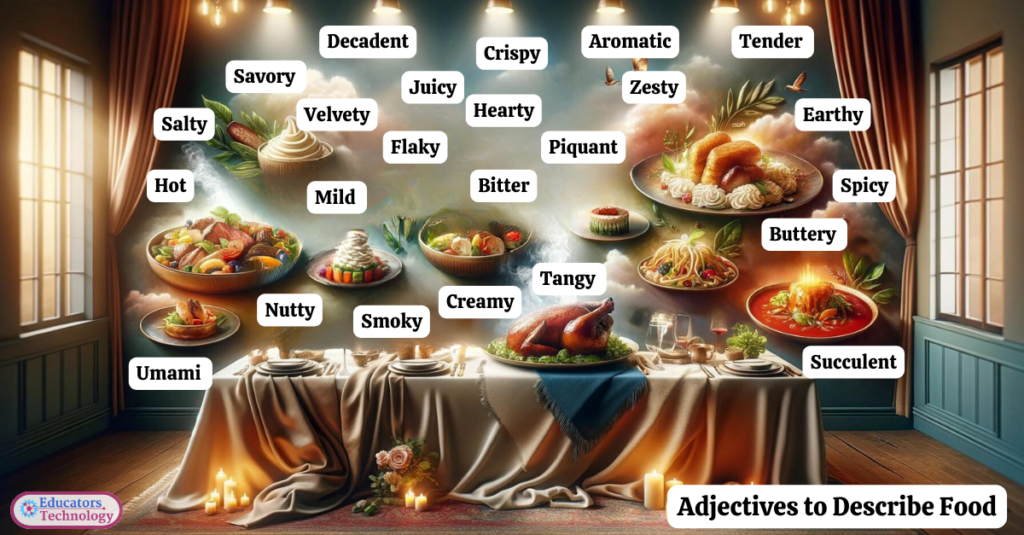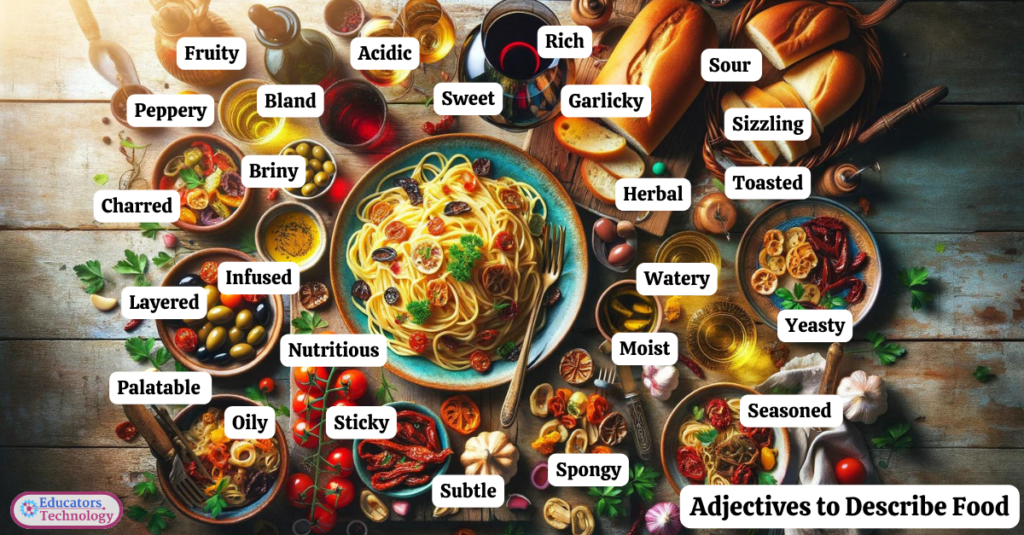I have recently embarked on a series of posts covering adjectives, driven by a simple rationale: to provide students and language enthusiasts with a toolkit for richer expression in their writing and daily conversations. Descriptive language is essential, not just for painting vivid pictures or setting scenes, but for engaging the senses, evoking emotions, and enhancing comprehension. It transforms basic communication into an art form, allowing us to share our experiences and perceptions with depth and nuance (Ricks & Alt, 2016).
In today’s post, the spotlight is on adjectives to describe food. These are words to use to words to savor, to pause, and to appreciate the culinary journeys we embark upon with each meal. Whether it’s the warmth of a home-cooked dish, the exhilaration of trying an exotic cuisine, or the comfort of a familiar favorite, these adjectives will definitely prove handy.
Also check out:
- Adjectives to Describe a Person Physically
- 50 Adjectives to Describe a House
- 60 Adjectives to Describe Movies
- Words and Adjectives to Describe a Person
- 80 Adjectives to Describe Feelings
- 60 Practical Adjectives to Describe Clothes
- Adjectives to Describe a Place
- 20 Engaging Activities to Teach Kids About Adjectives
Adjectives to Describe Food
Describing food in a way that truly captures its essence can make all the difference in how it’s perceived. Here are some practical adjectives to help you express the flavors, textures, and overall appeal of various dishes:

- Savory – Pleasantly salty or spicy, not sweet.
- Decadent – Luxuriously indulgent; rich and appealing to self-indulgence.
- Crispy – Having a pleasantly firm, crunchy texture.
- Aromatic – Having a strong, pleasant smell, typically used for spices and herbs.
- Tender – Soft and easy to chew, often used for meats.
- Zesty – Having a strong, pleasant, and somewhat spicy flavor or smell.
- Juicy – Full of juice; moist and flavorful.
- Velvety – Smooth, soft, and somewhat luxurious mouthfeel.
- Flaky – Breaking or separating easily into small, thin pieces, often used for pastries.
- Hearty – Providing warmth and nourishment; satisfying and substantial.
- Piquant – Having a pleasantly sharp taste or appetizing flavor.
- Umami – A savory taste that is one of the five basic tastes, along with sweet, sour, bitter, and salty.
- Nutty – Having the flavor or scent of nuts.
- Smoky – Having the flavor or aroma of smoked wood, often found in grilled or barbecued dishes.
- Tangy – Having a sharp taste or flavor immediately noticeable to the tongue.
- Creamy – Having a smooth, soft texture that is pleasantly rich and fatty.
- Fragrant – Having a pleasant or sweet smell, especially used for spices, herbs, and fruits.
- Bitter – Having a sharp, pungent taste or smell; not sweet.
- Succulent – Tender, juicy, and tasty.
- Mild – Not spicy, or only slightly spicy; gentle in flavor.
- Buttery – Rich, creamy, and smooth, reminiscent of butter.
- Spicy – Having a strong, hot flavor from spices.
- Earthy – Reminiscent of the natural flavors of soil or vegetation; often used for root vegetables or mushrooms.
- Fruity – Having the taste or aroma of fruit; sweet and tangy.
- Acidic – Sharp or sour in taste, with a high level of acidity.
- Rich – Full of flavor and fat, often deliciously so; very filling and satisfying.
- Peppery – Having a strong, hot flavor reminiscent of black pepper.
- Sour – Having an acidic taste like lemon or vinegar.
- Sweet – Having the pleasant taste characteristic of sugar or honey.
- Bland – Lacking strong flavor; mild or uninteresting.

- Garlicky – Containing or reminiscent of garlic.
- Herbal – Characterized by the flavor or scent of herbs.
- Briny – Having a salty, sea-like taste.
- Charred – Having a slightly burnt taste, often giving a desirable smoky flavor.
- Crunchy – Firm and making a loud, crisp sound when bitten or crushed.
- Gooey – Soft and sticky in a pleasing way; often used for desserts like brownies or cheese dishes.
- Sizzling – Very hot; making a hissing sound like food being fried.
- Toasted – Browned using heat, resulting in a richer flavor and crunchier texture.
- Watery – Lacking flavor, diluted; often not seen as desirable.
- Yeasty – Having the flavor or aroma of yeast, often used in the context of bread or beer.
- Infused – Flavored with added ingredients such as herbs, spices, or fruits.
- Layered – Having multiple layers of different flavors or textures.
- Moist – Slightly wet; often used to describe cakes, bread, and other baked goods.
- Nutritious – Providing nourishment; good for health.
- Oily – Containing a lot of oil; greasy.
- Palatable – Pleasant to taste.
- Robust – Strong and rich in flavor or aroma.
- Seasoned – Enhanced in flavor by the addition of spices and herbs.
- Seared – Quickly cooked at a high temperature so that the surface turns brown.
- Silky – Smooth, soft, and glossy, often used for soups or sauces.
- Smoked – Flavored by exposure to smoke from burning or smoldering material, usually wood.
- Spongy – Having a soft, porous texture.
- Sticky – Tending to adhere to objects upon contact; often used for sweets like candy or syrupy dishes.
- Subtle – Delicate and not obvious; often used for flavors or aromas that are not overpowering.
- Sugary – Containing a high amount of sugar; very sweet.
- Tart – Having a sharp, pungent taste; slightly sour.
- Toothy – Offering some resistance to the bite, yet tender; often used in the context of pasta cooking.
- Unleavened – Made without yeast or another raising agent, resulting in a dense texture.
- Velvety – Smooth, soft, and somewhat luxurious mouthfeel; similar to ‘silky’ but often richer.
- Zingy – Pleasantly stimulating, with a sharp taste or flavor.
Final thoughts
I hope you’ve found this collection of adjectives to describe food to be a savory addition to your linguistic pantry. In the same way that the right combination of ingredients can transform a simple meal into a memorable feast, the perfect selection of descriptive words can turn a basic sentence into a rich and vivid narrative. I encourage you to experiment with these adjectives in your own writing and conversations. Challenge yourself to go beyond the basic tastes and textures, and explore the emotional and cultural dimensions that food represents.
References
Ricks, S. L., & Alt, M. (2016). Theoretical Principles to Guide the Teaching of Adjectives to Children Who Struggle with Word Learning: Synthesis of Experimental and Naturalistic Research with Principles of Learning Theory. Language, Speech & Hearing Services in Schools, 47(3), 181–190. https://doi.org/10.1044/2016_LSHSS-15-0034.
The post 60 Adjectives to Describe Food appeared first on Educators Technology.
Title: 60 Adjectives to Describe Food
URL: https://www.educatorstechnology.com/2024/03/60-adjectives-to-describe-food.html
Source: Educational Technology
Source URL: https://www.educatorstechnology.com
Date: March 17, 2024 at 08:27AM
Feedly Board(s): Schule